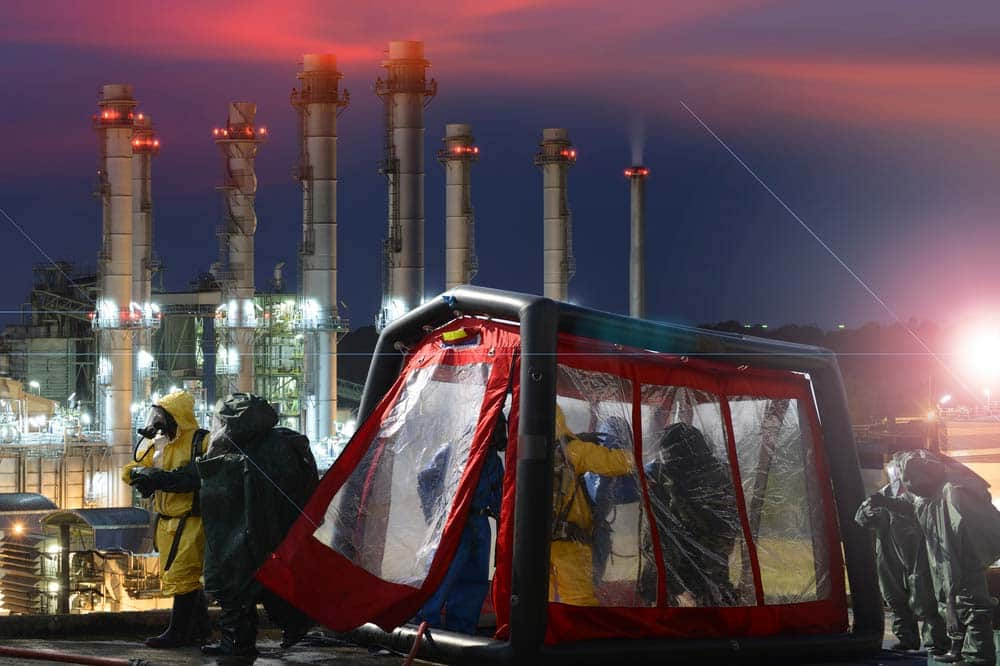HAZWOPER Decontamination
Decontamination
The process of removing or neutralizing contaminants that have accumulated on personnel and equipment is critical to health and safety at hazardous waste sites. Decontamination protects workers from hazardous substances that may contaminate and eventually permeate the protective clothing, respiratory equipment, tools, vehicles, and other equipment used on site; it protects all site personnel by minimizing the transfer of harmful materials into clean areas; it helps prevent mixing of incompatible chemicals; and it protects the community by preventing uncontrolled transportation of contaminants from the site.
This short article describes the types of contamination that workers may encounter at a waste site, the factors that influence the extent of contamination, and methods for preventing or reducing contamination. In addition, this narrative provides general guidelines for designing and selecting decontamination procedures at a site, and it presents a decision aid for evaluating the health and safety aspects of decontamination methods. The narrative does not cover decontamination of radioactively contaminated personnel or equipment. A health physicist should be consulted if this situation arises. A decontamination plan should be developed (as part of the Site Safety Plan) and set up before any personnel or equipment may enter areas where the potential for exposure to hazardous substances exists.

The decontamination plan should:
- Determine the number and layout of decontamination stations.
- Determine the decontamination equipment needed.
- Determine appropriate decontamination methods.
- Establish procedures to prevent contamination of clean areas.
- Establish methods and procedures to minimize worker contact with contaminants during removal of personal protective clothing and equipment (PPE).
- Establish methods for disposing of clothing and equipment that are not completely decontaminated. A plan should be revised whenever the type of personal protective clothing or equipment changes, the site conditions change, or the site hazards are reassessed based on new information. The first step in decontamination is to establish Standard Operating Procedures that minimize contact with waste and thus the potential for contamination.
For example:
- Stress work practices that minimize contact with hazardous substances (e.g., do not walk through areas of obvious contamination, do not directly touch potentially hazardous substances).
- Use remote sampling, handling, and container opening techniques (e.g., drum grapplers, pneumatic impact wrenches).
- Protect monitoring and sampling instruments by bagging. Make openings in the bags for sample ports and sensors that must contact site materials.
- Wear disposable outer garments and use disposable equipment where appropriate.
- Cover equipment and tools with a strippable coating which can be removed during decontamination.
- Encase the source of contaminants, e.g., with plastic sheeting or overpacks.
In addition, Standard Operating Procedures should be established that maximize worker protection. For example, proper procedures for dressing prior to entering the Exclusion Zone will minimize the potential for contaminants to bypass the protective clothing and escape decontamination. In general, all fasteners should be used (i.e., zippers fully closed, all buttons used, all snaps closed, etc.). Gloves and boots should be tucked under the sleeves and legs of outer clothing, and hoods (if not attached) should be worn outside the collar. Another pair of tough outer gloves is often worn over the sleeves. All junctures should be taped to prevent contaminants from running inside the gloves, boots, and jackets (or suits, if one-piece construction).
Prior to each use, the personal protective equipment (PPE) should be checked to ensure that it contains no cuts or punctures that could expose workers to wastes. Similarly, any injuries to the skin surface, such as cuts and scratches, may enhance the potential for chemicals or infectious agents that directly contact the worker's skin to penetrate into the body. Particular care should be taken to protect these areas. Workers with large areas of damaged skin should be kept from working on site until the skin heals. HAZWOPER personnel should be trained in the Standard Operating Procedures for minimizing contact and maximizing worker protection, and these procedures should be enforced throughout site operations.

